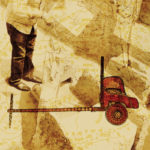Human Evolution: Written in Stone
A new finding in South India poses some tantalising questions on human evolution
 Lhendup G Bhutia
Lhendup G Bhutia
 Lhendup G Bhutia
Lhendup G Bhutia
 |
15 Mar, 2018
|
15 Mar, 2018
/wp-content/uploads/2018/03/Humanevolution1.jpg)
AS THE STORY goes, back in 1863, Robert Bruce Foote bent himself on a parade ground at Pallavaram Cantonment near Madras and, from the debris dug out from a small gravel pit, picked up an odd-shaped stone. Foote was a 29-year-old assistant geologist stationed in the Madras office of the Geological Survey of India. His job was to map the Madras Presidency and locate mines within the area.
This rough stone turned out to be a two-million-year- old hand axe made of quartzite. The young geologist had discovered the first palaeolithic site in British India. A few months later, again near Chennai, at an area called Attirampakkam, Foote and a colleague, William King, chanced upon more stone tools. These included flake tools, cleavers and hand axes that prehistoric men could have used to hunt animals and dig out tubers and roots from the soil. Soon, more were discovered at Pallavaram. It became increasingly probable that an ancient human population had once lived in these parts, and if someone were to get down to proper excavations, hidden underneath the layers of soil, in the shape of stone tools and artefacts, possibly even fossils, could be stories of a rich ancient past.
In his lifetime, Foote travelled across south India and discovered more than 450 prehistoric sites, from the Gudiyam caves of Tamil Nadu to the Tungabhadra valley and Hospet in Karnataka. Many of these sites continue to fascinate archaeologists and yield rich results to this day.
Precisely 155 years after Foote and his colleague made their discoveries in Attirampakkam, at the very same site, a team of archaeologists has now made another significant find. They have unearthed stone tools with sharply sculpted points—from what is known as the Middle Palaeolithic culture or the Middle Stone Age—so sophisticated that some researchers believe they must have been chipped into shape by members of our own species, Homo sapiens. But when these implements were sent to a laboratory for dating, a startling result awaited them. They were found to span a time period between 385,000 and 172,000 years ago. The strange thing is that Homo sapiens, according to conventional wisdom, were nowhere near modern-day Chennai then. They had only emerged in a small part of eastern Africa, somewhere close to what is now Ethiopia, and were yet to move out of that continent. The Out of Africa theory says this happened sometime between 125,000 and 60,000 years ago. The Middle Palaeolithic period in India, by that same theory, emerged 200,000 years later than what these new findings show.
So what exactly happened here? “Obviously we don’t know who its creators were. A lot more work needs to be done for that,” says one of the researchers associated with the study, Shanti Pappu. “But this finding is very very significant. It completely questions many accepted theories.” To archaeologists and evolutionary experts, this discovery, which was published in the journal Nature, reshapes our understanding of early human evolution and migration.
The story of human evolution is complicated. It did not occur in a simple linear fashion. There were a number of human species, some perhaps which haven’t yet been discovered or classified (although a few researchers argue that we have been far too liberal in classifying new human species). Only Homo sapiens survived. Did the other species just die out, or did our ancestors kill them? How did our species manage to colonise the world?
There are very few dots to tell a comprehensive story, but when joined using archaeological and genetic studies, they point to one group of humans leaving Africa and moving along the coastal route—we have been unable to find many of their bones since they would mostly be at the bottom of the sea now—in a single march and then using their superior intelligence and tools to take over the world.
But every year, that narrative gets more complex with fossils and tools being unearthed which show its limits. Researchers have found fossils in southern and central China dating between 70,000 and 120,000 years ago, long before they were supposed to have reached these parts. Others have been able to date the remains of human ancestors found in the Jebel Irhoud cave in Morocco that look a lot like Homo sapiens to around 300,000 years back in the past. And then there are a bunch of fossils discovered in the Israeli caves of Skhul and Qafzeh, and 106,000-year-old stone relics found in Oman, and 125,000-year-old stone artefacts in Jebel Faya, UAE, which resemble those created by modern humans during that period in Africa. We also know now that some of us today carry the genes of Neanderthals, Denisovans, and possibly other humanlike species, which suggests that our early ancestors interacted and mated with them. The stone tools of Attarapakkam adds an interesting dimension to the puzzle.
The Acheulian period came right before the Middle Paleolithic period. Here, human species used large unsophisticated hand-axes, cleavers and other heavy-cutting core stone tools. Primitive versions of these had perhaps been in use for more than a million years, but something happened between about 400,000 and 200,000 years ago, when revolutionary new stone tools began to be made. They were smaller, more diverse, pointed and sharper, with an emphasis on thin flake tools. These were portable, could be attached to sleeker shafts to make arrows, darts, spears and other projectile weapons. They could be used to perforate and scrape more efficiently and better deal with wood, hide and other such raw materials. It was a major technological advance for its time, helping its creators move into areas they hadn’t managed before.
According to one theory, Homo sapiens invented this new technology in Africa and introduced it to other archaic species, like the Neanderthal, when they encountered them as they migrated out of the continent. Others have theorised that different human species across the world came up with this technology independently on their own.
Researchers say there have been enough findings of new tools across the world to warrant a rethink on the Out of Africa theory. India, in particular, could be a key location that fills up some of the many gaps in the story of human evolution
Members of the team that carried out the study at Attirampakkam are academics of various disciplines, from archaeologists like Shanti Pappu and Dr Akhilesh Kumar of the Sharma Centre for Heritage Education in Chennai, to geochronologists like AK Singhvi, H Rajapara and AD Shukla of the Physical Research Laboratory in Ahmedabad, and a geomorphologist, Yanni Gunnell of France’s Université de Lyon’s department of Geography. Terming this a significant new study, Ravi Korisettar, a well-known Indian archaeologist from Karnatak University in Dharwad, a city about 425 km northwest of Bengaluru, points out how it is spawning new conversations. “Now people are wondering if Middle Palaeolithic tools were invented not by Homo sapiens, but some other older species, like the Homo heidelbergensis (an extinct human species), who are supposed to have emerged sometime between Homo erectus and Homo sapiens,” Korisettar says. The skulls of Homo heidelbergensis are believed to share features with both those of Homo erectus and Homo sapiens, indicative of brains nearly as large as ours. Of course, some palaeontologists contend that what have been identified as fossils of Homo heidelbergensis are merely variants of Homo erectus.
ATTIRAMPAKKAM, LOCATED SOME 60 km away from Chennai, is situated at the Kortallayar river basin. It is a remote piece of wasteland, hot and arid, surrounded by cultivated fields and dissected by a small stream. Pappu believes that thousands of years ago, the region could have been a verdant space, with water bodies and animals that it would attract, making it an ideal location for ancient people. “Prehistoric populations would have had an excellent knowledge of [these] past landscapes in their seasonal mobility patterns across this region,” she says.
After its discovery by Foote, Attirampakkam has been sporadically investigated for over a century, and as Pappu points out, significant conceptual developments in Indian prehistory studies owe their origin in research to this site.
There are many more prehistoric sites in and around Tamil Nadu that are throwing up interesting finds, but Attirampakkam remains one of the most important. Pappu, a former professor of prehistory at Pune’s Deccan College, has been studying this site since 1999. “Of all these sites, Attirampakkam is perhaps the most complex to understand, owing to its thick deposits and long culture sequence,” she says. “We have a whole team of scientists investigating various aspects of this site… That’s why we are still studying it for such a long time period, and the results show that this dedication is worth it.”
Prior to this find, Pappu and her team had mostly concentrated their focus on tools discovered in the lowest layers of the soil. Here, they had discovered Acheulian stone tools (the period before Middle Palaeolithic), and found incredibly early dates (of around 1.5 million years) even for these. Most implements from the Acheulian period here were simple and large (between 10 and 12 cm in size) and made by splintering rocks with either a hard stone or wooden or antler hammers. The detached flakes would then be shaped into tools of different kinds, like cleavers or hand-axes.
But now they have begun to analyse the tools retrieved from layers on top. “We excavated large horizontal trenches, test-pits and geological step-trenches across the site. These excavations were very meticulous, proceeding slowly, with documentation of everything we found. The deepest buried horizons contain tools representing a culture called the Acheulian and belonging to a phase termed the ‘Lower Palaeolithic’. Above these were around 3-metre thick deposits, with totally different types of stone tool assemblages,” she says.
The new tools are more complex in design and bear the markings of technologies used by Middle Palaeolithic cultures. According to Pappu, one can see gradual cultural shifts that took place here through changes in the stone tool assemblages. The researchers have classified all the tools of this period into two Middle Palaeolithic culture phases: an earlier one where a few archaic stone tools like hand-axes are still present but rapidly disappearing, and a later one where all these archaic tools have been replaced. “They preferred tools that were small (less than 10 cm in size), and slowly discarded the typical Acheulian handaxes and cleavers…. Methods of tool-making termed ‘Levallois’ and blade technologies began to be used to a greater extent,” Pappu says. “All these indicate a major shift in ways of hunting and gathering, with increased mobility and many other behavioural changes.” These tools are more complex and require an element of abstract thinking, which some consider unique to Homo sapiens. “Owing to the complete stratified sequence seen here [at the site],” Pappu points out, “we have a wonderful chance to examine changes through time.”
All the stone tools at the site, like their predecessors of the Acehulian period, are made of quartzite rock. Quartzite is found in hills about 2-3 km away from the site, which indicates a fairly wide extent of human activity. Interestingly, some other curiosities have also been found. The researchers have discovered animal teeth specimens (possibly bovine) and what look like animal footprints. These are now being analysed for future studies. They have also discovered a small quartz crystal piece that was brought to this site from elsewhere because it in all likelihood had some symbolic significance.
Pappu refuses to get drawn into the debate of who its creators could have been. “It is really impossible to speculate on which species made these tools,” she says. “There are two theories on the origins of the Middle Palaeolithic here or elsewhere in the world: dispersals of populations [from Africa into the rest of the world] with this culture [or] independent evolution [of these tools among various human species]… We cannot pinpoint the species owing to lack of fossils at this site.”
Korisettar, who had discovered the oldest Middle Palaeolithic tools in India before the current find by Pappu and her team, also refuses to speculate on who the creators of these tools may have been. But there has been enough evidence in the past few years he says to warrant a rethink on the Out of Africa theory. “We have always considered the fossils found in the Israel caves [of Skhul and Qafzeh] as part of a failed migration. There have been more finds now in the Arabian region, which puts modern humans right at the doorstep of Asia… Why is it impossible to believe that some of them made [these] here in Asia?” asks Korisettar.
India’s ancient humans have been understudied. Few sites in India have been dated and well explored. Also, archaeologists have had little luck in finding ancient human fossils here. But with this discovery, it shows that India could be a key location that fills up some of the many gaps in the story of human evolution. “This is because we are rich in sites and artefacts that have a wonderful story to tell. It is not merely the fossils, but the stone tools that are key to understanding behavioural changes through time… We believe that long-term projects are the key to unravel these mysteries,” Pappu says. “We don’t pretend to have all the answers, just some more clues to fill in a giant puzzle in a systematic manner.”
About The Author
CURRENT ISSUE
‘We Have Instilled Fear of the Law in Drug Syndicates,’ says Amit Shah
MOst Popular
4

/wp-content/uploads/2025/03/Cover_Amit-Shah.jpg)












More Columns
BJP allies redefine “secular” politics with Waqf vote Rajeev Deshpande
Elon Musk attracts sharp attack over ‘swastika’ from Indians on social media Ullekh NP
Yunus and the case of a "land locked" imagination Siddharth Singh